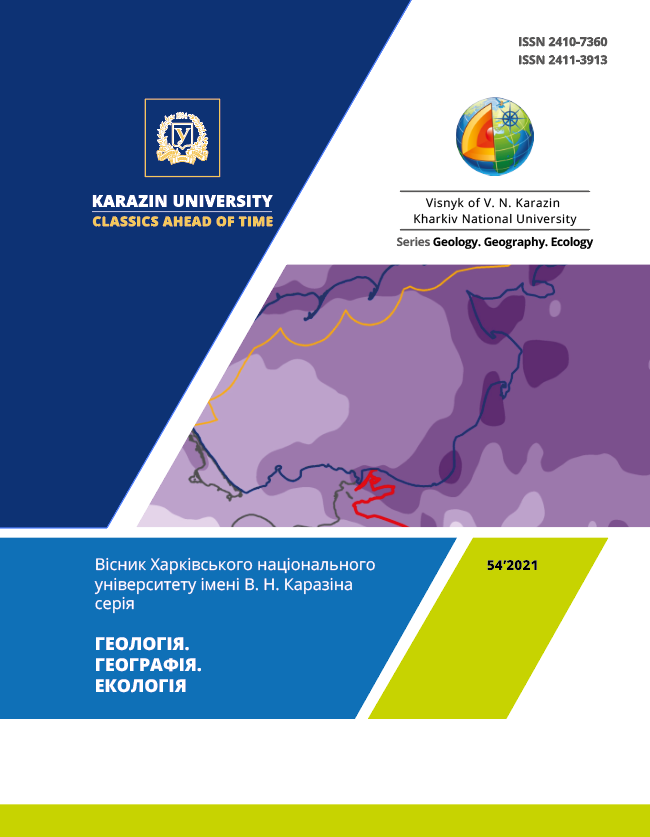Водень як індикатор геодинамічних процесів вугленосних товщ
Анотація
Проблема розробки та впровадження пошукової технології, яка забезпечить захист гірничих виробок та унеможливить катастрофи при розробці вугільних родовищ особливо актуальна зараз, коли питання природоохоронних засобів та підвищення безпеки праці на вугільних шахтах стоїть дуже гостро. Нова розробка безпечної пошукової технології вугільних родовищ, що запропонована авторами, дозволить завчасно відслідковувати, виділяти місця можливих проявів газодинамічних явищ та приймати оперативні рішення для їх усунення. Авторами проведено аналіз сучасного стану вуглевидобутку в України і в світі в цілому; обґрунтовано доцільність використання безпечної пошукової технології в зонах розвитку шахтних полів для виділення перспективних ділянок концентрацій водню в місцях вуглевидобутку, що слугують прямими детонаторами газодинамічних явищ, а також доведено доцільність випереджальних заходів, що унеможливить появу газодинамічних явищ. Вперше в світовій практиці було запропоновано новітні підходи щодо зміни парадигми безпеки видобутку вугілля, які попередять непрогнозовані ГДЯ та пов’язані з ними матеріальні та людські втрати. Технологія базується на застосуванні пошукових газогеохімічних методів для картування місць накопичення газово-водневих скупчень та їх ділянок і разом з комплексом геолого-геофізичних методів дозволяє виділяти площі можливих аварійних процесів в зонах розвитку шахтних полів. На великому масиві проведених польових робіт, площової та профільної зйомок доведена доцільність застосування пошукової технології для обґрунтування використання закладання випереджальних дегазаційних свердловин для запобігання некерованих вибухонебезпечних процесів і технічних катастроф. Запропонована технологія була апробована на чисельних видобувних об’єктах в процесі пошуково-екологічних досліджень в зонах розвитку діючих та відпрацьованих шахтних полів.
Завантаження
Посилання
Vernadsky V.I. (1960). Selected Works. Moscow: publishing house of the USSR Academy of Sciences, 422.
Semenenko N.P. (1990). Oxygen-hydrogen model of the earth. Kiev: Naukova Dumka, 246.
Voitov G.I., Osika D.G. (1982). Hydrogen respiration of the earth as a reflection of the features of the geological structure and tectonic development of its megastructures. Proceedings of the Geological Institute. Makhachkala, 26, 7-29.
Marakushev A.A., Marakushev S.A. (2008). Hydrogen respiration of the earth – its origin, geological and biological consequences. Alternative energy and ecology, 57, 152-170.
Bagriy I.D., Kuzmenko S.O., Naumenko U.Z., Zubal S.D. (2019). New technology for exploration of hydrogen accu-mulations and forecast of geodynamic phenomena. 13th International Conference on Monitoring of Geological Processes and Ecological Condition of the Environment Kyiv, Ukraine, 1-4.
Bagriy I.D., P.F. Gozhik, A.A. Repkin, S.A. Kuzmenko, A.A. Loktiev, V.G. Semenuk. (2019). Rationale of search tech-nology on hydrogen and geodynamic phenomena (oil and gas regions, minefields). Geol. zhurn., 2 (367), 18-28. DOI: https://doi.org/10.30836/igs.1025-6814.2019.2.169931
Bagriy I.D., Kuzmenko S.A. (2019). Scientific substantiation of the spatial distribution and mapping of anomalous manifestations of hydrogen – the energy raw material of the XXI century – in the oil and gas structures of Ukraine and the prevention of geodynamic phenomena. Geol. zhurn., 1 (366), 59-77. DOI: https://doi.org/10.30836/igs.1025-6814.2019.1.159241
Bagriy I.D., Naumenko U.Z., Maslun N.V., Dubosarsky V.R., Zhalovsky V.M., Maryukhno V.M. (2017). Modern scien-tific approaches to the development of ecologically oriented technologies for exploration of hydrocarbon and groundwater deposits. Fourth International Scientific and Practical Conference "Subsoil Use in Ukraine. Invest-ment Prospects". Ukraine, Truskavets, 62-64.
Gladun V.V., Dovzhok T.Ye., Yevdoschuk M.I. (2000). Independent object of hydrocarbon exploration in the Dnieper-Donetsk gas and oil region. Oil and gas industry, 5, 6-9.
GOST 23781-87. Combustible natural gases. Chromatographic method for determining the component composi-tion, 11.
Demyanenko I.I. (2004). Problems and optimization of oil and gas prospecting and exploration works at the ob-jects of the Dnieper-Donetsk basin. Chernihiv: State Center for Science, Innovation and Informatization, 220.
Porotov G.S. (2006). Mathematical modeling methods: Textbook. St. Petersburg State Mining University (Tech-nical University), 223.
Porfiryev V.B., Krayushkin V.A., Klochko V.P., Ponomarenko M.I., Palamar V.P., Lushpey M.M. (1982). A new direc-tion of geological exploration in the Akhtyrka oil and gas production area of the Dnieper-Donetsk depression. Geol. Journ., 4, 4, 1-11.
Ryaboshtan Yu.S. (1980). On the content and tasks of structural-geodynamic mapping during prospecting and ex-ploration works at hydrothermal-type deposits. Sedimentary rocks and ores. Kiev, Nauk. Dumka, 126-135.
Sokolov V.A. (1971). Geochemistry of natural gases. M., Nedra, 336.
Sollogub V.B. (1986). Lithosphere of Ukraine. Kiev, Nauk. Dumka, 184.
Soyak L. (2003). Separation and identification of isomeric hydrocarbons by capillary gas chromatography and its combinations with mass spectrometry and FTIR spectroscopy. Rus. chem. Journ. (J. of the Russian Chemical Socie-ty named after D.I.Mendeleev), XLVII, 2, 51–69.
Pearson E.S., Hartley H.O. (1972). Biometrica tables for Statistics. Cambridge, University Press, 634.
Geological Journal. Institute of Geological Sciences. Available at: http://geojournal.igs-nas.org.ua/article/view/9967. DOI: https://doi.org/10.30836/igs.1025-6814.2018.2.133461
Mineral resources of Ukraine. Ukrainian state geological research institute: https://mru-journal.com.ua/index.php/mru/article/view/296. DOI: https://doi.org/10.31996/mru.2020.4.28-38





